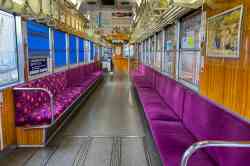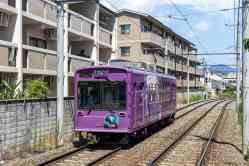 Urban Electric Transit
Urban Electric TransitKyoto
京都市
Editors: nikwotnik, tkyk196, narrow_1, pukkuri_heart, Rokkor_XD.
Comments: all · tramway · trolleybus · metro · funicular · electric Bus
Quick Vehicle SearchPhotos By RouteTramway Facilities / OperatorsKeihan group
Kyoto Municipal Transportation Bureau
Museum
Trolleybus Facilities / OperatorsKyoto Municipal Transportation Bureau
Subway Facilities / OperatorsKyoto municipal subway
Keihan group
Kintetsu Railway
Funicular Facilities / OperatorsKeihan group
Electric Bus Facilities / OperatorsCity Photo GalleriesRapid TransitInformationKyoto Public Transportation includes subway, trams*, buses, and various railway lines.The Subway consists of two intersecting lines that operate through services with adjacent railway lines to Nara and the interurban to Otsu. Subway Lines: [*] Karasuma Line. Runs from north to south, connecting Kokusaikaikan Station in the north and Takeda Station in the south. Suitable for accessing Kyoto Station and central areas. At Takeda Station, the Karasuma Line is connected for through service with the Kintetsu Nara Line. Kintetsu trains provide direct connections between Nara and Kokusaikaikan Subway Station. [*] Tozai Line. Runs from west to east, connecting Uzumasa Tenjingawa Station in the west and Rokujizo Station in the east. Useful for visiting attractions such as Nijo Castle. At Misasagi Station, the Tozai Line is connected to the Keishin Interurban. Keihan trains run from Biwako-Hamaotsu Station in Otsu to Misasagi Station, then along the Tozai Line to Uzumasa Tenjingawa Station. On our website, Keihan trains are attributed to Otsu. Tram The classic city tram system in Kyoto closed in the 1970s. In the mid-20th century, Kyoto had an extensive tram network connecting all parts of the city and running throughout the grid of major city streets. Currently, there are 2 separate systems in Kyoto, conditionally classified as trams, operated by different operators, but part of the same Keihan group of companies. These tram systems operate in the format of a "small urban railway," according to railway rules, but have sections on a shared roadbed with the street and road network. [*] Eizan Railway (Eiden). Shugakuin Depot. Consists of two lines. A scenic railway connecting the Sakyo district with Kurama and Kibune, known for their temples and nature. [*] Randen (Keifuku Electric Railroad). Sai Depot. Consists of two lines. – Arashiyama Line — connects Arashiyama and northern Kyoto — Kitano Line — connects the Kamigyo-ku area with Kitabiranosuji Station on the Arashiyama Line Private Railway Operator Lines [*] Keihan Line. Runs along the eastern side of Kyoto, connecting with Fushimi Inari Shrine, Gion, and Uji. Partially underground. Connects Kyoto with the center of Osaka. On our website, it is added in the format of a subway. [*] Hankyu Line. Connects Kyoto with Osaka and Kobe, with stops in the Arashiyama area. Connects Kyoto with the center of Osaka, perpendicular to the Keihan Line. In Kyoto, it runs from west to east and ends in the Kawaramachi area. Has an underground section. In Osaka, some trains run on the Sakaisuji Subway Line. On our website, it is added as a subway line attributed to Osaka. [*] Kintetsu Line. Connects Kyoto with Nara and Ise. Some trains run beyond Takeda Station onto the Karasuma Line of the Kyoto Subway. Trains operating through service between the Kintetsu Line and the Karasuma Subway Line are also added to our website as a separate enterprise. JR Railway Lines [*] Tokaido Main Line. Connects Kyoto with Osaka on one side, and on the other side in Otsu, it divides into the Biwako and Kosei Lines, connecting Kyoto with Kusatsu, Hikone, and Tsuruga, respectively. [*] Sagano Line (San'in Main Line). Connects Kyoto Station with the Arashiyama area, famous for its bamboo forest and temples, and continues to Fukuchiyama. [*] Nara Line. Connects Kyoto Station with Uji (known for its Byodoin Temple) and Nara (a UNESCO World Heritage city). [*] Tokaido Shinkansen. High-speed railway connecting Kyoto with Osaka, Tokyo, and other major cities. To obtain up-to-date train schedules and plan routes, you can use applications such as Google Maps or Japan Travel by Navitime. VideoActive Photographers of the City1st place: nikwotnik — 34 photos2nd place: Котофей — 25 photos 3rd place: Palal — 20 photos Full list of photographers |
Random Photo New Photos     
|
Dark Theme
© TransPhoto administration and authors of photos, 2002—2025
Using any images from this website without authors' permission is prohibited.
Using any images from this website without authors' permission is prohibited.





















